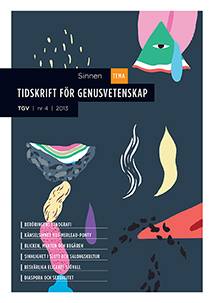Sinnlighetens slott. Eva-Marie Liffners Drömmaren och sorgen som queert allkonstverk
DOI:
https://doi.org/10.55870/tgv.v34i4.3343Nyckelord:
Eva-Marie Liffner, queerteori, queert skrivande, gottgörande läsning, sinnen i litteraturen, sinnesintryck, estetikAbstract
This article is a close reading of Eva-Marie Liffner’s 2006 novel Drömmaren och sorgen (The Dreamer and the Sorrow). Drawing on theories of queer and lesbian literature and on the writings of Gilles Deleuze, I argue for a queer aesthetics of sensual excess. Liffner’s novel is a mystery without a solution, a beautiful enigma resisting reader expectations of plot and closure. Its labyrinthine or kaleidoscopic structure connects and reconnects a large amount of vivid, concrete figures. I read the novel through five of its key figures: the castle, the sea, the heart, the song and the knight. The castle is the architectural principle of the novel, which features gothic elements such as the trapdoor and the secret passage. The sea lends atmosphere to the novel and is best understood as an element in the humoural sense, permeating landscapes and characters alike. The heart exemplifies Liffner’s use of intensely sensual figures and connects to the genre of anatomical blazons. The song points to an alternative, musical organisation of the novel and works to transcend barriers of sex and species. The knight, finally, is identified as the androgynous hero(ine) of queer literary history riding through works such as Virginia Woolf’s Orlando and Djuna Barnes’ Nightwood before showing up in Liffner’s novel.
Nedladdningar
Downloads
Publicerad
Nummer
Sektion
Licens
Författaren/författarna behåller copyright till verket.





